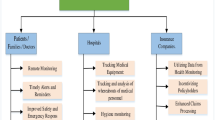Abstract
In recent days, the Internet of Medical Things (IoMT) is commonly employed in different aspects of healthcare applications. Owing to the increasing necessitates of IoT, a huge amount of sensing data is collected from distinct IoT gadgets. To investigate the generated data, artificial intelligence (AI) models plays an important role to achieve scalability and accurate examination in real-time environment. However, the characteristics of IoMT result in certain design challenges, namely, security and privacy, resource limitation, and inadequate training data. At the same time, blockchain, an upcoming technology, has offered a decentralized architecture, which gives secured data transmission and resources to distinct nodes of the IoT environment and is stimulated for eliminating centralized management and eliminates the challenges involved in it. This paper designs deep learning (DL) with blockchain-assisted secure image transmission and diagnosis model for the IoMT environment. The presented model comprises a few processes namely data collection, secure transaction, hash value encryption, and data classification. Primarily, elliptic curve cryptography (ECC) is applied, and the optimal key generation of ECC takes place using hybridization of grasshopper with fruit fly optimization (GO-FFO) algorithm. Then, the neighborhood indexing sequence (NIS) with burrow wheeler transform (BWT), called NIS-BWT, is employed to encrypt the hash values. At last, a deep belief network (DBN) is utilized for the classification process to diagnose the existence of disease. An extensive experimental validation takes place to determine the analysis of the optimal results of the presented model, and the results are investigated under diverse aspects.








Similar content being viewed by others
References
Dwivedi AD, Srivastava G, Dhar S, Singh R (2019) A decentralized privacy-preserving healthcare blockchain for IoT. Sensors 19(2):326
Abdolkhani R, Gray K, Borda A, DeSouza R (2019) Patient-generated health data management and quality challenges in remote patient monitoring. JAMIA Open ooz036. https://doi.org/10.1093/jamiaopen/ooz036
Rahman MA, Hossain MS, Loukas G, Hassanain E, Rahman SS, Alhamid MF, Guizani M (2018) Blockchain-based mobile edge computing framework for secure therapy applications. IEEE Access 6:72469–72478
Griggs KN, Ossipova O, Kohlios CP, Baccarini AN, Howson EA, Hayajneh T (2018) Healthcare blockchain system using smart contracts for secure automated remote patient monitoring. J Med Syst 42(7):130
Chen Y, Ding S, Xu Z, Zheng H, Yang S (2019) Blockchain-based medical records secure storage and medical service framework. J Med Syst 43(1):5
Liang X, Zhao J, Shetty S, Liu J, Li D (2017) Integrating blockchain for data sharing and collaboration in mobile healthcare applications, in: Proceedings of the 28th IEEE Annual International Symposium on Personal, Indoor, and Mobile Radio Communications (PIMRC), pp. 1–5, https://doi.org/10.1109/PIMRC.2017.8292361.
Zhang P, White J, Schmidt DC, Lenz G, Rosenbloom ST (2018) Fhirchain: applying blockchain to securely and scalably share clinical data. Comput Struct Biotechnol J 16:267–278
Brogan J, Baskaran I, Ramachandran N (2018) Authenticating health activity data using distributed ledger technologies. Comput Struct Biotechnol J 16:257–266
Gordon WJ, Catalini C (2018) Blockchain technology for healthcare: facilitating the transition to patient-driven interoperability. Comput Struct Biotechnol J 16:224–230
Rupasinghe T, Burstein F, Rudolph C, Strange S (2019) Towards a blockchain based fall prediction model for aged care, in: Proceedings of the Australasian Computer Science Week Multiconference, ACM, p. 32.
Dorri A, Kanhere SS, Jurdak R (2017) Towards an optimized blockchain for IoT. ACM, pp 173–178
Gaetani E, Aniello L, Baldoni R, Lombardi F, Margheri A, Sassone V (2017) Blockchain-based database to ensure data integrity in cloud computing environments, in: Italian Conference on Cybersecurity, Venice, Italy. 17 – 20 Jan 2017, p. 10.
Novo O (2018) Blockchain meets IoT: An architecture for scalable access management in IoT. IEEE Internet Things J 5(2):1184–1195
Rathore S, Pan Y, Park JH (2019) BlockDeepNet: a Blockchain-based secure deep learning for IoT network. Sustainability 11(14):3974
Elhoseny M, Shankar K, Lakshmanaprabu SK, Maseleno A, Arunkumar N (2018) Hybrid optimization with cryptography encryption for medical image security in Internet of Things. Neural Comput & Applic:1–15
Neve AG, Kakandikar GM, Kulkarni O (2017) Application of grasshopper optimization algorithm for constrained and unconstrained test functions. Int J Swarm Intell Evol Comput 6(165):2
Xiao C, Hao K, Ding Y (2015) An improved fruit fly optimization algorithm inspired from cell communication mechanism. Math Probl Eng:2015
Uthayakumar J, Vengattaraman T, Dhavachelvan P (2019) A new lossless neighborhood indexing sequence (NIS) algorithm for data compression in wireless sensor networks. Ad Hoc Netw 83:149–157
Yu J, Liu G (2020) Knowledge-based deep belief network for machining roughness prediction and knowledge discovery. Comput Ind 121:103262
The International Skin Imaging Collaboration, ISIC Archive, https://isic-archive.com/, Accessed on June 14, 2020.
Acknowledgment
The author K. Shankar sincerely acknowledge the financial support of RUSA–Phase 2.0 grant sanctioned vide Letter No. F. 24-51/2014-U, Policy (TNMulti-Gen), Dept. of Edn. Govt. of India, Dt. 09.10.2018.
Author information
Authors and Affiliations
Corresponding author
Ethics declarations
Conflict of interest
The authors declare that they have no conflict of interest. The manuscript was written through contributions of all authors. All authors have given approval to the final version of the manuscript.
Additional information
Publisher’s note
Springer Nature remains neutral with regard to jurisdictional claims in published maps and institutional affiliations.
Rights and permissions
About this article
Cite this article
Alqaralleh, B.A.Y., Vaiyapuri, T., Parvathy, V.S. et al. Blockchain-assisted secure image transmission and diagnosis model on Internet of Medical Things Environment. Pers Ubiquit Comput 28, 17–27 (2024). https://doi.org/10.1007/s00779-021-01543-2
Received:
Accepted:
Published:
Issue Date:
DOI: https://doi.org/10.1007/s00779-021-01543-2




